 is Apple Watch Ultra 2 Accurate? – Cadence bug, otherwise good accuracy all around
is Apple Watch Ultra 2 Accurate? – Cadence bug, otherwise good accuracy all around
Return to: Apple Watch Ultra 2 Review
More: Apple Watch 10 Review
I’ll refine that title. The general level of GPS accuracy of the Apple Watch Ultra 2 errs towards excellent but is let down in precisely the circumstances where dual-frequency reception is supposed to give accuracy – nearby tall buildings and valleys. Heart rate accuracy is person-specific and use-case-specific but was generally more than acceptably good for me but I’m not selling my heart rate strap any time soon.
There is a running cadence bug and I would assume that cadence is an input for the running power determination. Go figure, stick with Stryd
GNSS Accuracy
Most people interested in general accuracy are most interested in GPS accuracy, so I’ll start here.
Most of you seem keen to look at the results of my 10-mile accuracy test which is just one test I use to come to an overall view on GPS accuracy. That link should cover all the responses to concerns you might raise about this kind of test. For example, I fully appreciate seasonal issues and issues with the positions of satellites. The latter no longer makes any difference as most modern sports watches have very many satellites to access in multi-constellation modes…that wasn’t true 10 years ago with GPS-only watches where HDOP issues sometimes occurred. We have entered the golden age of GPS accuracy but don’t expect to see significant steps beyond the current situation for many years to come.
- Bottom Line: Only the Suunto VERTICAL has scored higher GPS accuracy results on this test than the Watch ULTRA 2, and yes, that includes Polar V800, AMBIT 3, and all key Garmins.
- Reality: Suunto Vertical, Garmin Epix2, Coros APEX2/PACE 3 Forerunner 965/955 have effectively the same GPS accuracy across all real-world conditions
10-Mile Run
ULTRA 2 uses a dual-frequency, multi-constellation GPS/GNSS chipset. Multiple constellations mean that sufficient satellites are nearly always visible high in the sky, and dual frequency allows untrustworthy positional information to be discarded from individual satellites. ULTRA 2 performed excellently across a range of GPS hazards and did not exhibit any especially unusual behaviours except perhaps very slight rounding on tight corners.

Here are three areas where the ULTRA 2 did not perform correctly. The first two are next to high buildings. Suunto Vertical is notably superior here. The third image depicts a WTF moment that followed several similar WTF moments, I’ve no idea why ULTRA 2 had me running about 5m away on the wrong side of the road especially when 500m later in the same conditions it was perfectly fine.
Note that I always use satellite imagery to determine the true road/track positions as some of the manmade maps (above) always have slightly misplaced tracks somewhere on them.
More high buildings
I am a glutton for punishment. The 10-mile test is pretty awesome in its predictiveness but I still keep plugging away trying to prove something different. Here we have more higher buildings in Kingston which is a large, British town rather than a City but with 8-storey buildings. It’s not downtown Manhattan but then it doesn’t need to be because none of the watches are perfect here so I’m pretty darn sure they won’t be in Manhattan either where conditions are tougher.
That said, these tracks are reasonably accurate. If you look closely you have a Eureka moment when you discover one watch nails it only then to mess up a few 10s of metres later. The reality is that none of these watches properly use dual-frequency signals to eliminate incorrect readings. The technology should be able to do that as of today but more improvement is needed.
As you can see, if you zoom out far enough you can make all these tracks look good. But the zoomed-in reality is that there are often 5m errors.
#shrug. This is what I would expect. It’s pretty good though.
English Suburbia
The glory of well-spaced out English semi-detached 2-storey houses. It’s not exactly UTMB-like conditions but, let’s face it, how many of us really run in those conditions every day? thought not! We all do that sort of thing sometimes, of course, I’ll test out something along those lines in a few weeks’ time.
This shows a really very good set of tracks from FR965 and ULTRA 2. This was my first one with Vertical for a while and maybe its almanac wasn’t updated perhaps explaining why it was only ‘fairly good’ rather than excellent.
Even 3 years ago, the previous generation of GPS tech couldn’t quite nail English Suburbia. Now it can. Usually.
Moderately Dense Woodland, never with a clear sight of the sky
This was a challenging GPS test with LOTS of tree cover. Watch ULTRA 2 and Forerunner 965 were mostly inseparable in terms of quality; perhaps FR965 edged it a bit. Suunto Vertical was strangely inaccurate to an unacceptable level often more than 5m out.
Q: Does Apple Watch ULTRA 2 use intelligent dual-frequency reception like Garmin’s SatIQ
A: That detail of information is not published although Apple does use dual-frequency reception. However, such a feature would save considerable battery power and it’s almost certain that Apple uses it as a result.
Cadence Bug
As you can see it’s easy to spot the cadence bug
Heart Rate Accuracy
This tempo run shows excellent HR. The Garmin comparator was supposed to be Elevate 4 optical, so the label could be wrong. Either way, Apple is good.

Here it’s the HRM-PRO PLUS which drops out its connection to my FR935. there are some very minor discrepancies if you look intently enough at the other tracks but this steady-state run posed no problems to Ultra 2.
These are some short sprints with different kinds of recovery and jogs/walks into the sprints. Ultra 2 suffers a couple of dropouts but there’s not much else to see here really.
 I wasn’t feeling too great when I ran these varying-intensity efforts. It didn’t really work out from an execution perspective. It didn’t work out either for ULTRA 2 and HRM PRO PLUS (FR935) both showing dropouts albeit not too concerning for the Ultra. What was more concerning for Ultra 2 was the circled section halfway through where it overestimated my efforts too quickly
I wasn’t feeling too great when I ran these varying-intensity efforts. It didn’t really work out from an execution perspective. It didn’t work out either for ULTRA 2 and HRM PRO PLUS (FR935) both showing dropouts albeit not too concerning for the Ultra. What was more concerning for Ultra 2 was the circled section halfway through where it overestimated my efforts too quickly
4-minute Running Intervals
Watch Ultra 2 misses the HR climb to one of the peaks but is otherwise OK on these VO2max intervals on tarmac..
Gym – heart rate accuracy
This is a quick upper-body workout focussed on exercises with a lot of arm/wrist movement. As you can see there is no agreed correct track but the broad trend is discernable. Other than the Garmin fails on several occasions, the rest all seem similar enough. Note: Once again, there is little point in measuring heart rate for strength workouts as the heart rate is NOT a valid way to calculate strength training load. Only WHOOP adds accelerometer movements in its app to account for other factors and thus get a better handle on training load.
Note: Other users are reporting HR issues. This might be a more extreme version of the occasional dropout I see in the diagrams above.
Overnight HRV Accuracy
I don’t have much data here yet but what I have so far is an 85% baseline correlation between ULTRA 2 (overnight) and a Polar H10 morning reading, which is promising. I appreciate data is collected in different ways over different time periods but both purport to broadly indicate the same thing physiologically.
Take Out
I don’t often need super precision accuracy, except for running pace. However, I just don’t want to have to worry about my data sometimes being VERY inaccurate. As recently as 2 or 3 years ago I’m not sure I would have trusted any of the leading sports watch companies to avoid those moments of data madness.
I think we might be approaching the point now where OHR and GNSS are just about broadly reliable. They’ll mess up very infrequently but will be broadly trustworthy. but that’s still not enough to tempt me away from my Garmin chest strap and my STRYD running power meter/pace pod. Those two produce as accurate a set of data for me as is possible right now so there is just no point in my moving away.
If you just buy the latest Garmin or Apple watch then you should be alright on the accuracy front. But there are no guarantees when using onboard sensors.
So Apple Watch ULTRA 2’s accuracy is amongst the best of the best. I can see this top echelon of sports watches getting slightly more accurate as the manufacturers refine the various algorithms they use. The one thing Apple needs to do is work a bit harder to perfect its use of dual-frequency satellite signals as this is precisely what ULTRA conditions demand…the Watch needs to live up to its name and all that’s implied by it.

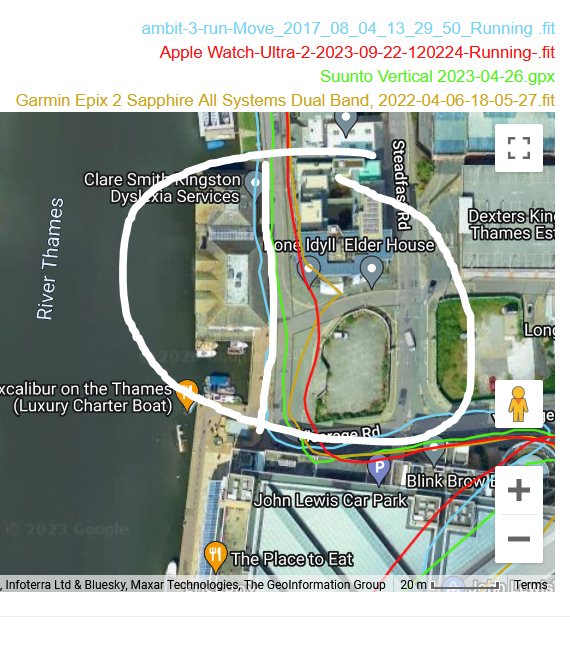

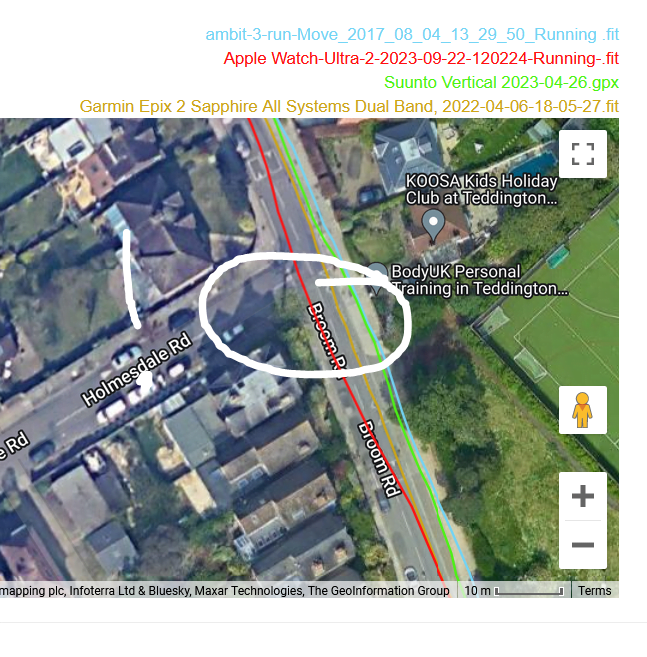
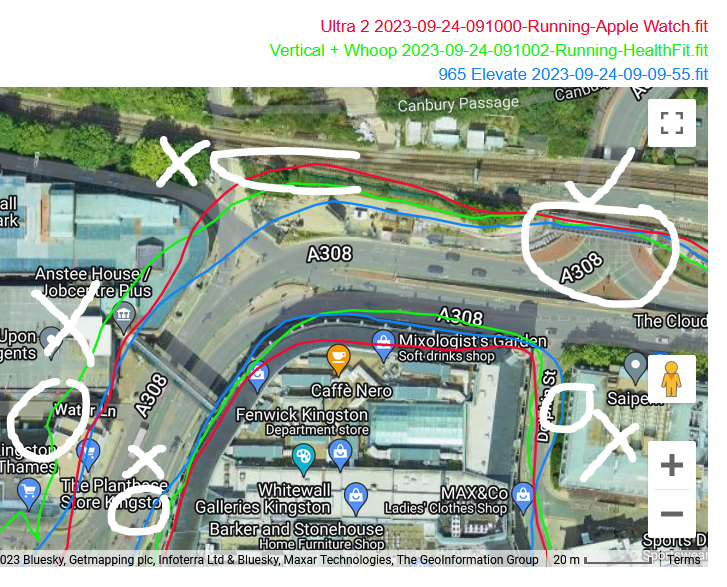
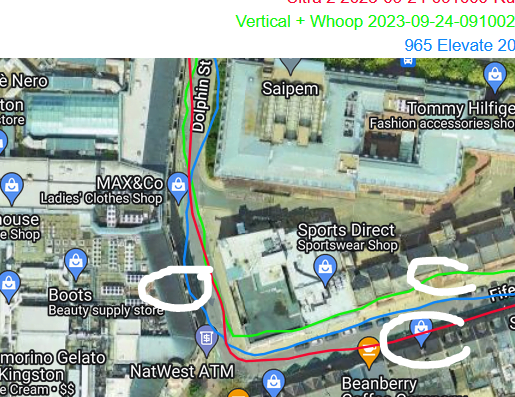
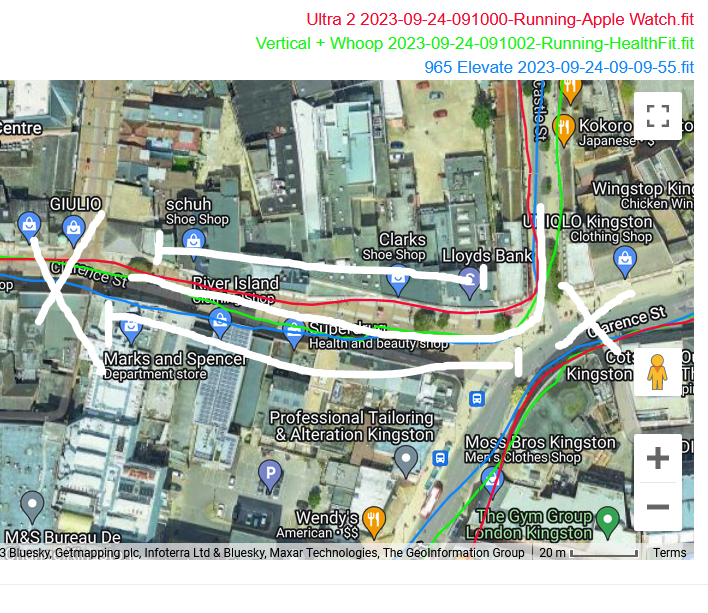
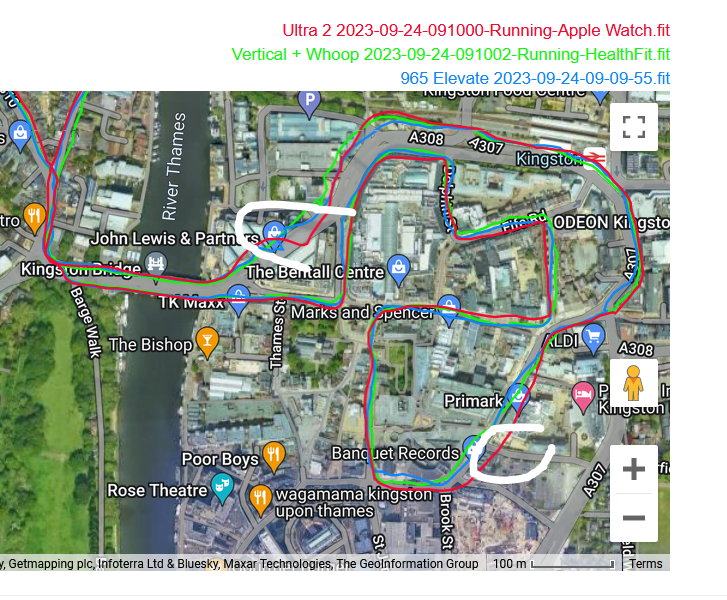


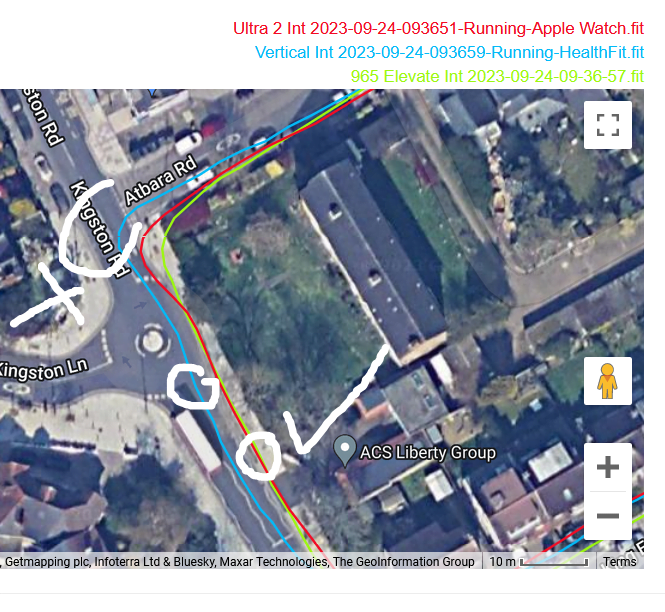



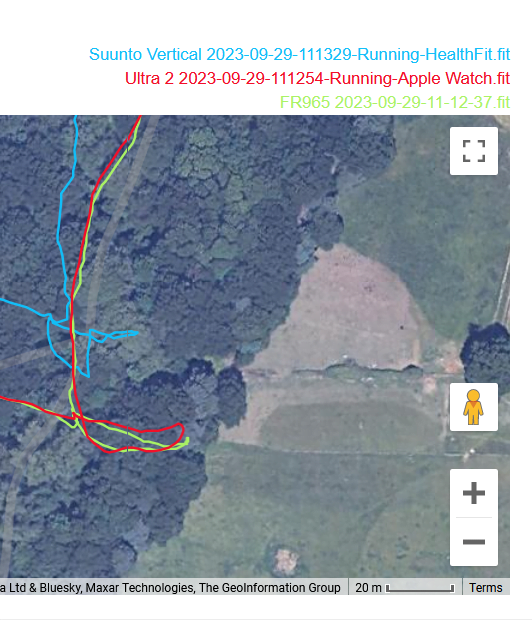







Just a cool talk on how GPS actually works: https://www.youtube.com/watch?v=XjRHl2Rr9tQ
Where I always have an issue with all Apple Watches is total distance. I run primarily on heavily wooded trails, so GNSS reception can be tough, but the AWs I’ve used always come up 5-10% short (AW7 and now an AWU2). This is compared to a Garmin 955, which in my testing has shown to be highly accurate both for distance and GNSS accuracy.
If I dig deep into the data, it appears Apple is aggressively rounding down the raw GNSS distance. I’m currently trying out the Ultra 2, and on a few longer trail runs, the raw GNSS distance is comparable to the 955 (using https://quantified-self.io), but the converted distance is dialed back by that 5-10%. This bugs the s*** out of me as I was really hoping to ditch the Garmin for most of my runs.
In open space and on streets, like in your 10-mile test, the AW lines up nicely. I was really hoping the dual-band in the AWU would bring a bit more precision in the woods, though. Have you seen similar results in any of your testing? It’s hard to find detailed reviews for these things geared towards trail running.
hi
yes one of the tests is in fairly dense woodland
the route of my 10-mile test is also specifically chosen to include several KMs under tree cover (large trees). the linked spreadsheet has the distance info.
I’m not seeing great gps accuracy from my ultra 2 which is frustrating. My Garmin 265 is crazy accurate and maybe has set my expectations too high. Have you seen any wobbles in your testing? Thanks.
ty for that feedback
apart from as I outline above…no! seems very accurate to me and mostly indistinguishable from FR965 with SatIQ
My Ultra 2 has accuracy issues with calories and elevation gain. I run the same route every day 5.1 miles. With my series 9 the elevation gain is around 16 feet and calories around 480. With the Ultra 2 I have seen elevation of from 100 feet to 900 feet. Calories from 200 to 1100. It was sent in for repair and still not accurate.
F.J. says:
This is intended for what you (5K Runner) said and relates to what, by contrast, GrayCow said. He or she mentioned “not seeing great GPS accuracy from [his or her] ultra 2”. However, you mentioned accuracy readings off by 5 metres under tough conditions, but usually much better.
Yer, when home with an Apple iPhone SE and tracking my elderly wife wearing the ultra 2, (GPS + cellular plan) and using an Apple map, I am getting readings under ideal conditions (she’s on open ground in a park with few trees) that are sometimes off by more than 150 m. or so and only rarely accurate within 5 m. As well, at times the readings jump around in just a few seconds showing her in different places about 30 m. apart at more or less the same time.
I’ve checked with Apple tech support about this and they have been very good to help me set the watch settings for precision reading. So far, nothing they are suggesting regarding all the key location settings is helping.
I have no idea how to explain how erratic the location finding seems to be. Re. the jumping around, I’ve wondered if the ultra 2 is showing a GPS reading sometimes and a cellular reading shortly after, and the two should but don’t match. Anyhow, I’m left with the feeling the ultra 2 location finding is not up to the standards of a Garmin device. I had one some years back that was much more accurate (despite a much less developed satellite system) than the ultra 2 I have now. Can you comment on all this?
maybe the Watch SE takes the reading from the paired iPhone. ultra 2 should not. rn without the phone to be sure as a check.
i assume you’ve checked the basics like properly wearing it and not reversing the position of the digital crown
assuming you are doing everything correctly then there is something wrong with your watch.
in my experience with apple they are really very bad at admitting any kind of fault once youve got past any return period. good luck.